I turned a year closer to 50 this month, and Ling surprised me with the newly released Samsung Galaxy Watch as a birthday gift just before we left for Taiwan. Ahhhh!! Only thing is that while I wouldn’t mind another smartwatch and have been keeping a lookout for it since October, I’d deliberately rejected the Galaxy Watch. This first iteration in Samsung’s Galaxy Watch series improves upon their existing line of Gear watches. I also love the Samsung Gear Sport‘s rotating bezel and fluid operating system, but its 1.5 to 2 day battery life is seriously limiting. The Galaxy Watch has improved in this latter regard yes – but its now 2 to 2.5 full days of use honestly still doesn’t cut it. With that kind of limited longevity, you can’t really wear and forget the device, never mind that the Galaxy Watch is also a pretty beefy device. So, in good part also that the last thing I wanted to was to bring to Taiwan a watch that I had to charge everyday, I settled for the Amazfit Bip then and intended to wear it for the trip.
With the wife’s blessing, I sold away her Galaxy Watch birthday present at minimal loss – thankfully – and since the wife agreed too, went straight for the one just released smartwatch that, finally, puts to bed this battery issue issue that’s been plaguing smartwatches everywhere. And it’s the Huawei Watch GT.
There are two versions of the watch: a normal edition @ SGD299 that comes with a rubber silicon strap, and a slightly more expensive ‘classic’ edition @ SGD328 that comes with a super cool leather strap. We were just a day from leaving for our trip though, and the Watch GT while already in Singapore if only through Huawei Concept Stores, seemed sold out on our island. But I got lucky : I found a small number of units still available at the iChangi store, albeit the classic and slightly more expensive edition. Since our flight was heading out of Changi Airport at 6:50am on Friday morning, I made an immediate order on Thursday lunch time – and just 10 minutes before the pick-up window of 18 hours minimum disallows a purchase against my flight departure time. The order was successful and confirmed. I paid just over SGD300 for it at iChangi (sans GST), though the watch today is now available even cheaper from third party resellers on Lazada. The new watch was packed and ready to be picked-up after we cleared immigration at Changi Airport.
I’ve since worn the watch for two weeks to and back from Taiwan, so here are my notes on it!
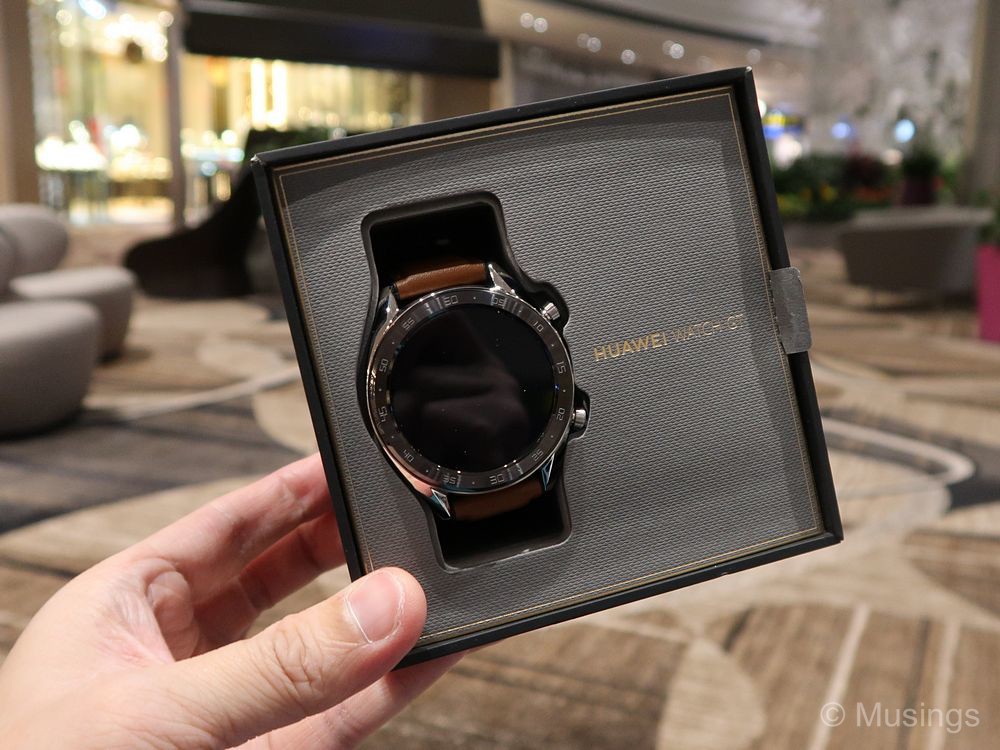
Like Huawei’s premium line of smartwatches and phones, the Watch GT comes with a soft-surface box that sees the watch securely packed, a charger/dock, USB-cable, and the usual paperwork. The charger also uses the USB-C standard – very nice! Won’t be long now when the only cables I need to use around my devices are USB-C ones only.
The classic edition’s leather strap has a reverse silicon side. While some light water splashing on it e.g. under a tap when washing hands should be fine, it doesn’t look like it can withstand persistent immersion in water, e.g. from swimming. Thankfully, the Watch GT accepts standard 22mm straps, so I’ve placed an order for a silicon strap to replace the leather one and that I’ll use it for day to day wear and save the leather one if I’m at an event where I need to look a little more formal.
The Watch GT uses a magnetic-type dock. Oh dear. I disliked the magnetic dock on my Huawei Watch from two years back – the dock’s charging pins wore out so quickly that it became increasingly hard for the watch to line up perfectly against the charging pins for it to get power. The Watch GT seems to have improved a little in this regard and it’s easier to get it to align properly for a magnetic lock-in. Nonetheless, I’ve placed an order for two more cheapo third party charging docks so that I can also put put aside the original dock for safe-keeping. Either way, I would have really preferred a wireless charging solution – like what I’ve got on the Samsung Gear Sport and might have had I kept the Galaxy Watch. And if not, a dock with some sort of physical latch – like what the charging cradle that the Amazfit Bip uses.
The Watch GT has a 420mAh battery, and is rated at 14 days, and it’s really that good in normal use. In my first day of use, the battery dropped about 12% because of my setting-up and fiddling around with the new toy. But in the days to follow once I’d settled in and got used to it, battery drop was about 5 to 6% during the day time and another 2% or so when I’m sleeping – which when added up suggests that it’ll indeed run for a fortnight. I need the watch to run reliably for at least seven days, so 14 days is plenty of headroom. According to Huawei’s advertising, you can even double that to 30 days if you enable only message and incoming call notifications. Charging speeds though are somewhat pedestrian, even if you finally don’t have to do it very often given the watch’s marathon life. It took 18 minutes for the dock to replenish 10% of battery. So by extrapolation, it should take 3 hours to fully recharge a depleted battery. In comparison, the Samsung Galaxy Wear’s larger 472mAh battery takes a quicker 2 hrs 51 minutes to fully replenish, according to GSMArena.
I reckon that the Watch GT’s battery longevity is because of two reasons. Firstly, Huawei’s proprietary Lite OS that the watch runs on is exactly that: it’s skimpy on smartwatch type features and there’s no app store to speak of nor a music player. It seems to offer the standard fitness and health tracking (excepting tracking floors climbed, like the Amazfit Bip), and Huawei Health, the accompanying Android app, is good enough for me even if it’s not really as slick as Samsung’s equivalent app. Caution to note though: I wear these things primarily for smartwatch notifications and need it just to do some simple health-tracking – so the Watch GT’s built-in feature set might feel gimped, like what some reviewers have remarked. I might miss the absence of the music player though. The Samsung Gear Sport supports it, and it’s terrifically useful if I wanted to take a jog outside and not have to bring a smartphone with me.
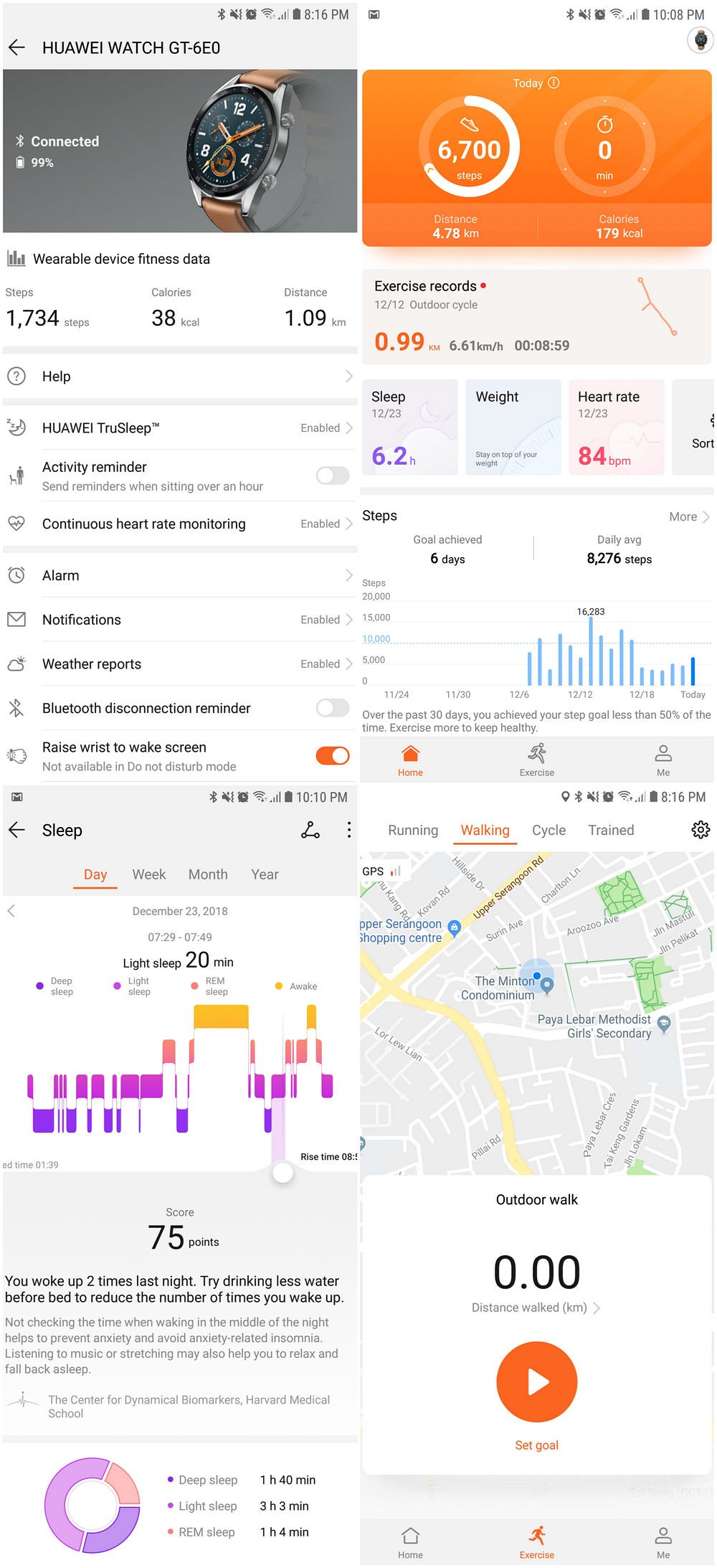
The other reason for its battery longevity is that the GT is a dual-processor design, with hardware specifically designed to support low-power modes when there isn’t much going on, e.g. when I’m sleeping. That’s a really clever inclusion by Huawei into the Watch GT and I don’t think the other watch manufacturers will be far behind including this feature into their future smartwatch iterations too.
Aside from a more than 7 day battery life, my other non-negotiable requirement for a day to day use watch is that it needs to have a good screen i.e. preferably an AMOLED or equivalent-type display. The GT has a 1.39″ AMOLED display – the biggest I’ve ever used. It also has a very high 454×454 pixel resolution – making this 326 ppi watch display one of the sharpest around. The watch is even larger on account of its bezel, which aside from the minute markings on the bezel doesn’t really have any other use. I’ve been spoiled by the rotating bezel on the Samsungs! Thankfully the Watch GT’s bezel is relatively skinny.
LiteOS also doesn’t seem like a mature OS at this point. The most obvious evidence of that is the absence of third party watch faces. You’re stuck with whatever the watch currently comes with, and there are about 11 of them currently, with an additional one that was recently added in a firmware upgrade. None of these watch faces are customisable at all too- and that’s a major bummer. You’re stuck exactly with the faces you’re given with no ability to change color scheme or remove face elements, like I could with my Android Wear and Samsung Gear watches . Additional watch faces and also customization are two of the most popular wish-list features for firmware upgrades now in some Huawei forums. Also, you can use the Huawei Health app to customize the GT to alert you to specific types of notifications, but there’s no way to actually reply to any message-type notifications, like the Amazfit Bip – something that’s included in the Apple, Wear OS and Tizen-OS watches. Thankfully, that’s not a feature I miss, since I’ve hardly ever use the reply feature on my other watches anyway.
Furthermore, there are oddities in how the watch behaves. For example, there’s no option to permanently enable the display, or what smartwatches routinely call the Always On Display. I wonder whether this was an intentional feature omission on Huawei’s part to achieve their 14 day battery life. Sure, enabling an AOD will exhaust your battery a lot quicker, but I’d rather the option had been made available for users to decide if want to enable it than not to have the option to at all. The closest equivalent of an AOD on the Watch GT is “Show Time”, a setting where I can set the display the watch face to be on for 5 minutes. But that option itself seems similarly half-cooked: the setting seems to immediately forget itself once the watch face times-out. Moreover, coming out of the fluid animations on the Gear Sport, the Watch GT in comparison seems not only to lag a little when swiping, but the animation transitions from screen to screen also seems to stutter. Lastly, the Raise Wrist to Wake Screen is also not reliable: it doesn’t recognize my lift wrists almost half the time. Outside pressing either of the watch’s two buttons, the most reliable way to wake the display is for me to shake my wrist vigorously for half a sec.
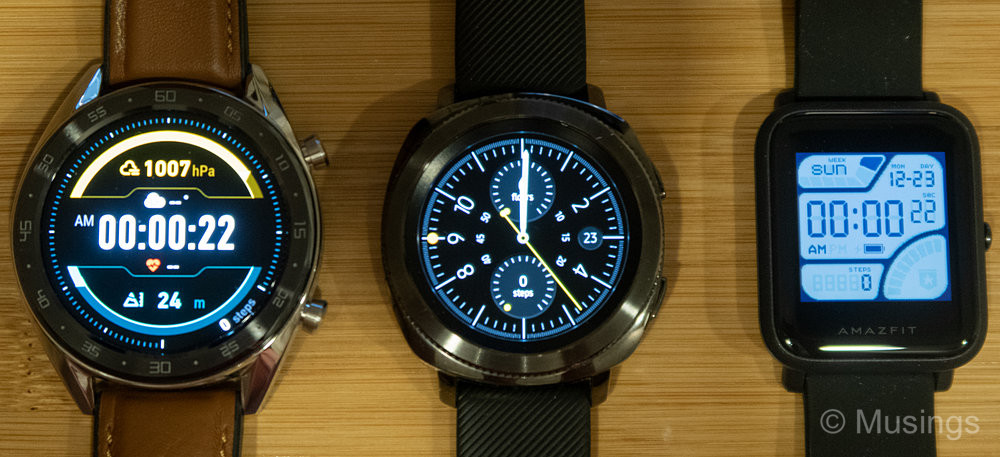
Finally, the three watches are clearly quite different in size and girth, and I get a very different sensation wearing each of the three. The Watch GT is by far the largest of the three – yep I can feel it on my wrist – but not the heaviest at 61g (with strap) compared to the Gear Sport’s 67g. The Bip weighs next to nothing at 32g, and with its very comfy silicon strap, I can’t feel it when it’s worn. The Bip is in fact the only watch I don’t have to take off when I’m on the piano, whereas both the Gear Sport and Watch GT’s masses are enough for me to be conscious that I’m wearing a wrist watch. Comfort-wise, the Gear Sport sits somewhere in the middle.
More pictures:
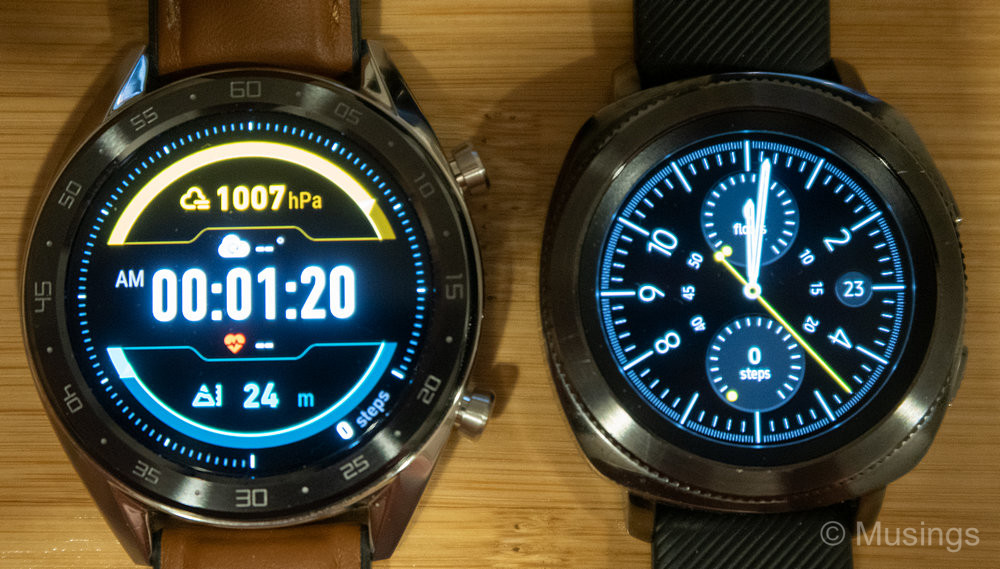
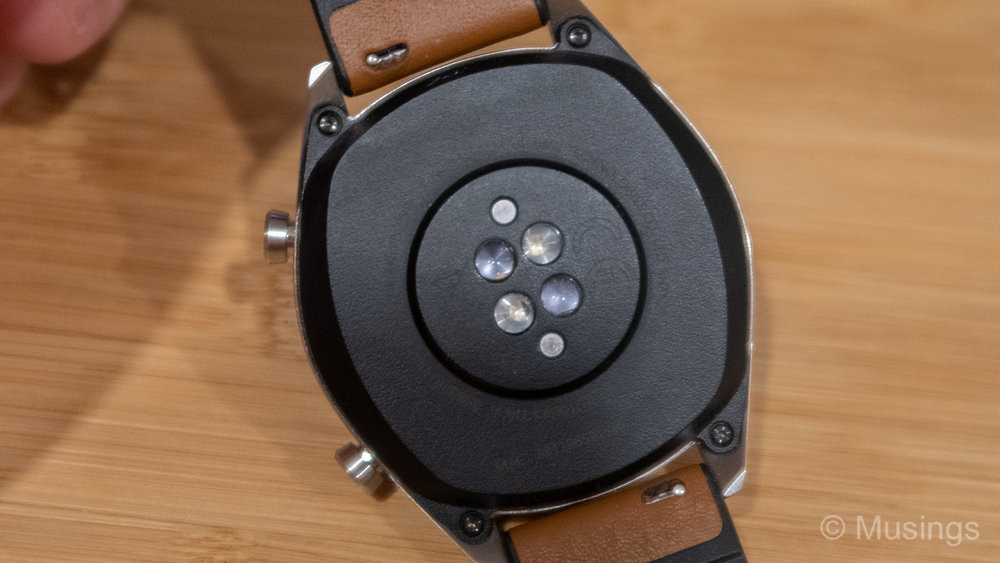
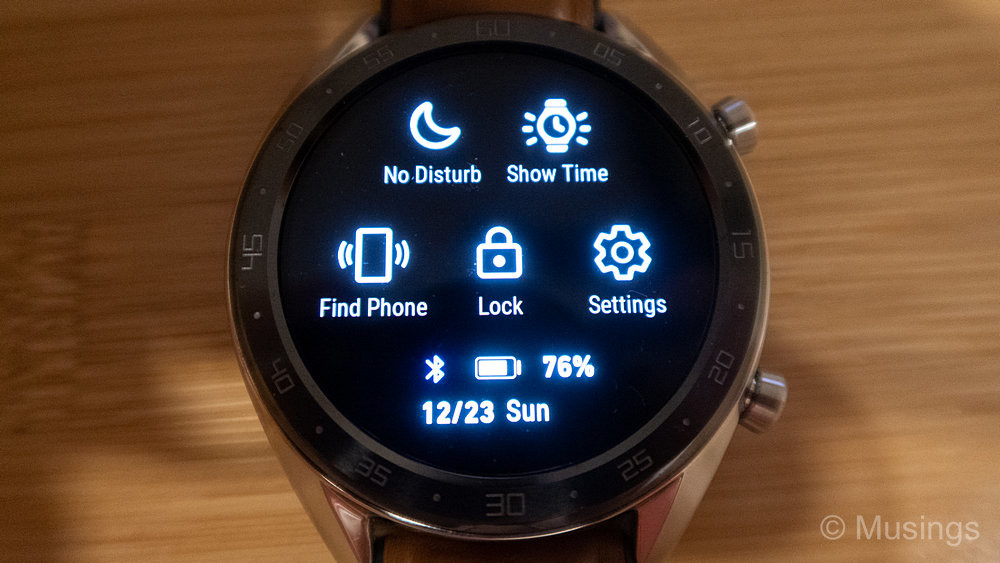
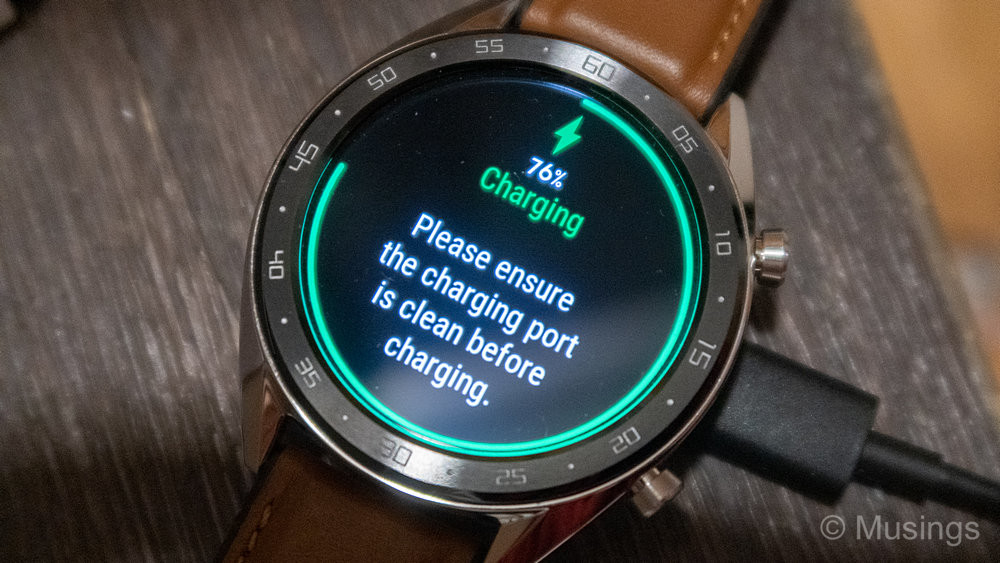
Bottom line: the Samsung Watches still remains the best overall watch OS I’ve used and is the non-Apple Watch wearable I’d recommend first – but only if you can live with its 2-3 day battery life. If substantial battery life is important to you, then the Huawei Watch GT is the next best smartwatch, albeit one with a few compromises. Go for it!
Recent comments